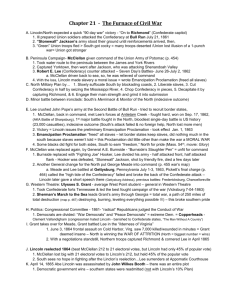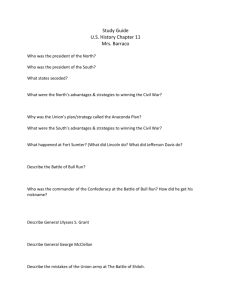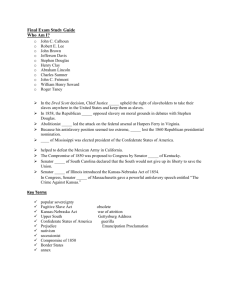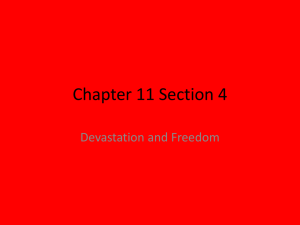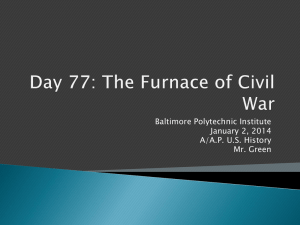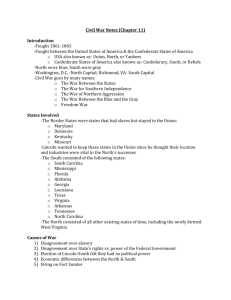Civil War Notes
advertisement
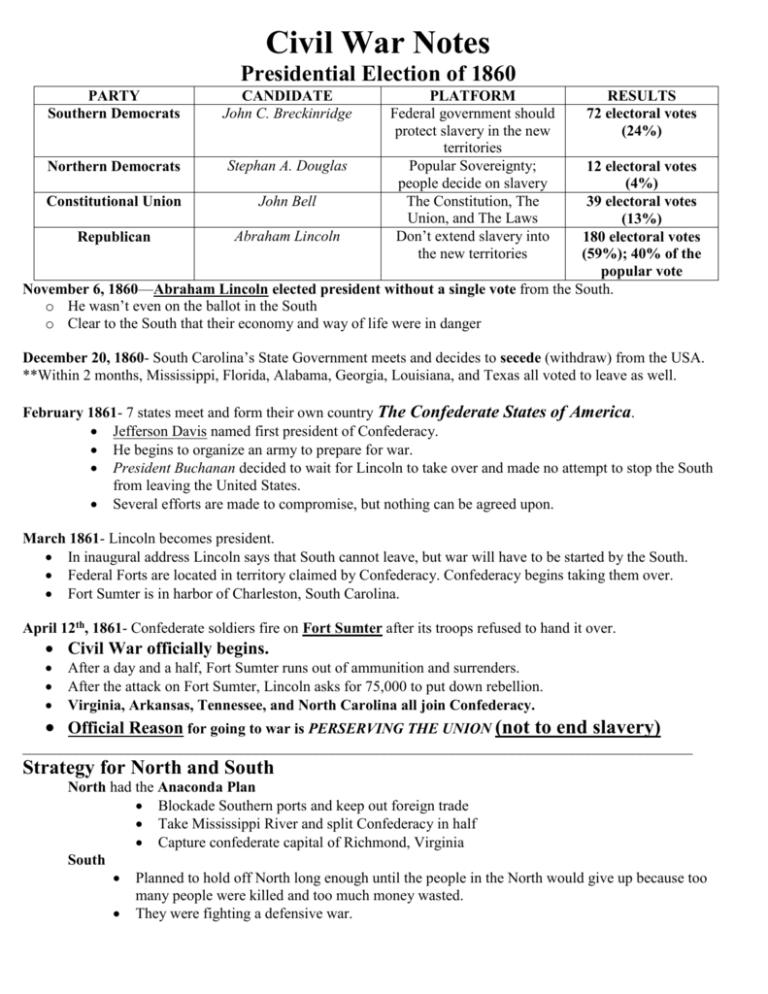
Civil War Notes Presidential Election of 1860 PARTY Southern Democrats CANDIDATE John C. Breckinridge Northern Democrats Stephan A. Douglas PLATFORM Federal government should protect slavery in the new territories Popular Sovereignty; people decide on slavery The Constitution, The Union, and The Laws Don’t extend slavery into the new territories RESULTS 72 electoral votes (24%) 12 electoral votes (4%) John Bell Constitutional Union 39 electoral votes (13%) Abraham Lincoln Republican 180 electoral votes (59%); 40% of the popular vote November 6, 1860—Abraham Lincoln elected president without a single vote from the South. o He wasn’t even on the ballot in the South o Clear to the South that their economy and way of life were in danger December 20, 1860- South Carolina’s State Government meets and decides to secede (withdraw) from the USA. **Within 2 months, Mississippi, Florida, Alabama, Georgia, Louisiana, and Texas all voted to leave as well. February 1861- 7 states meet and form their own country The Confederate States of America. Jefferson Davis named first president of Confederacy. He begins to organize an army to prepare for war. President Buchanan decided to wait for Lincoln to take over and made no attempt to stop the South from leaving the United States. Several efforts are made to compromise, but nothing can be agreed upon. March 1861- Lincoln becomes president. In inaugural address Lincoln says that South cannot leave, but war will have to be started by the South. Federal Forts are located in territory claimed by Confederacy. Confederacy begins taking them over. Fort Sumter is in harbor of Charleston, South Carolina. April 12th, 1861- Confederate soldiers fire on Fort Sumter after its troops refused to hand it over. Civil War officially begins. After a day and a half, Fort Sumter runs out of ammunition and surrenders. After the attack on Fort Sumter, Lincoln asks for 75,000 to put down rebellion. Virginia, Arkansas, Tennessee, and North Carolina all join Confederacy. Official Reason for going to war is PERSERVING THE UNION (not to end slavery) _________________________________________________________________________________________ Strategy for North and South North had the Anaconda Plan Blockade Southern ports and keep out foreign trade Take Mississippi River and split Confederacy in half Capture confederate capital of Richmond, Virginia South Planned to hold off North long enough until the people in the North would give up because too many people were killed and too much money wasted. They were fighting a defensive war. Leadership for North and South General Winfield Scott was commander of Union Forces General Robert E. Lee turned down the Union Command when his home state of Virginia left the Union. He became commander of Confederate Forces. Advantages of North and South North 1) Larger population=more soldiers 2) More industry=more military supplies (weapons, bullets, clothing, etc...) 3) Better roads=faster transportation 4) More railroads=faster transportation South 1) Better military leaders 2) Fighting to keep their way of life 3) Fighting on home ground 4) Cotton needed in Europe so better chance for getting foreign help New Weapons & Tactics Breech-loading rifles—could load easier, shoot farther and more accurate o Fighting becomes impersonal (don’t see the other person) o Calvary (horses) looses importance o Frontal infantry (soldier) attacks are no longer effective o Relied more on tactics Ironclads—ships made out of wood with iron plates over it (like armor) Monitor (Union) v Merrimac/Virginia (Confederate)—March 8, 1862 1st naval battle of the ironclads neither side wins but Union still able to blockade Virginia’s ports ______________________________________________________________________________________________ First Battle of Bull Run—July 21, 1861 Both sides thought the war would be over in 6 months. Lincoln orders General McDowell with 37,000 to attack Confederate troops in Virginia not far from Washington DC Spectators come to see the fighting Lincoln hopes for quick victory that would lead to Union taking Confederate capital Richmond North looses-retreating army and spectators run back to Washington DC Seven Days Battles—June 25-July 1, 1862 General McClellan (UNION) creates the Army of the Potomac Plans to sail south of Richmond and move north to capture city McClellan beaten back by Lee General Lee was afraid that if the South didn’t win quickly, the North’s industrial advantage will make it impossible for South to win Battle of Shiloh in Tennessee (April 6-7, 1862) o Confederates were still sleeping in their beds o Tough fighting; thousands dies o General Grant (Union) was victorious o Lessons from Shiloh Send out scouts; dig trenches; build fortifications NO EASY VICTORY (no short war) Battle of New Orleans—April 25-May 1, 1862 o Union Naval forces capture New Orleans from Confederacy o North tries to control all of Mississippi River Second Battle of Bull Run—August 28-30, 1862 o Lee advances into Northern Virginia o South wins at Bull Run again o South goes from defensive to offensive battle plan Battle of Antietam—September 17, 1862 Lee follows up victory at Second Bull Run with invasion of Maryland, a Union State. McClellan versus Lee McClellan is lucky to find Grant’s plans wrapped up with cigars—meet at Antietam Creek Bloodiest day in American History; over 27,000 dead and wounded men South win even though the North had 30,000 more troops (but can’t follow up on victory) McClellan is fired by Lincoln because for letting Lee get away ______________________________________________________________________________________________ Lincoln prepares the Emancipation Proclamation—Issued January 1, 1863 o Slaves were providing crucial services to the Confederate war effort so Lincoln had to do something to stop this advantage o EP stated that all slaves in Confederate States were free o Did not free one slave o Slaves that were in states that did not secede from the Union are NOT FREE o Inspired the North & weakened the Southern war effort o Goals of the war change WAS Preserving the Union to NOW slavery (equality) ______________________________________________________________________________________________ Foreign Relations during the Civil War A. Great Britain a. Upper class supports the South—economic reasons b. Lower class supports the North—did not support slavery i. Remained neutral 1. Internal conflict would be too great 2. had too much cotton 3. Needed northern wheat 4. British experts had predicted that the South would loose the war a. Did provided 2 battleships to the South that did a lot of damage b. After the war they paid $15 million for the damages the boats did B. France a. Upper class favored the South b. Raised millions of $$$ for the South c. Thought a Southern victory would loosen the control of the Monroe Doctrine i. 1862—established a puppet government in Mexico; after the war USA kicks them out C. Russia a. Favored the North b. Liked anti-slavery c. Sent ships to New York & San Francisco i. Friendly gesture towards USA ii. Warning to French & British 1. In 1867 USA buys Alaska from Russia ______________________________________________________________________________________________ By 1863 both North and South are forced to start CONSCRIPTION (the draft) Confederates: 18-35 yrs old; could pay $10,000 to not go to war; for every 20 slaves one male could stay home Union: 20-45 yrs old; also can pay for substitutes o “rich man’s war, poor man’s fight” South –starving; inflation is high; slaves are leaving the plantations and helping the Union forces North—economic & agricultural boom; making lots of $$$ from the war Congress during the war starts funding for a transcontinental railroad (Atlantic to Pacific) & passes the Homestead Act which gives 160 acres of free land to citizens who settle out west Women during the Civil War were very active both on the North and the South ran farms(S); worked in factories(N); worked for the government; became nurses o had to be over 30 yrs old and plain looking o Clara Barton becomes the founder of the American Red Cross Prisoner of War Camps (P.O.W.)—most famous Andersonville, GA (S) & Camp Douglas, IL (N) Southern camps had no food, shelter, or medical help Northern camps a little better but Southern troops were not use to cold northern winters ______________________________________________________________________________________________ December 11-15, 1862 Lee wins again at Battle of Fredericksburg (Virginia) After firing McClellan after Antienam, Lincoln appoints General Burnside to run the Union Army After the loss at Fredericksburg, he is also fired and replaced by General “Fighting Joe” Hooker May, 1863 General Hooker vs. General Lee & “Stonewall” Jackson at Battle of Chancellorsville Confederates Win! o General Thomas “Stonewall” Jackson killed in battle o Lee looses best General but decides to attack the North on their land! GETTYSBURG July1-3, 1863-turning point of war o o o o o General Meade and General Lee’s armies meet at Gettysburg, Pennsylvania Battle lasts 3 days Bloodiest battle of the Civil War 51,000 killed Lee is forced to retreat back to South TURNING POINT OF THE WAR o South never able to invade North again & South cannot replace their troops anymore o General Meade does not follow Lee; Lincoln mad and he gets fired! July 4, 1863—Battle of Vicksburg o General Grant tries 5 times to take Vicksburg Mississippi o Grant is able to split the Confederacy into two and takes Vicksburg o Last Confederate stronghold on the Mississippi River March, 1864—President Lincoln is re-elected o He names General Grant supreme commander of Union Forces o Grant’s plan is to keep Lee trapped in Virginia o War of attrition—North has more men so keep fighting and wear the South down o Example: in one month Grant lost 60,000 men! May-June, 1864- Wilderness Campaign Grant leads army into Virginia Lee and Grant fight a series of battles that were indecisive, but the North could always replace soldiers easier than the South Jun 15, 1864-March 25, 1865—Siege of Petersburg o Lee is caught in city by Grant o 10 months spent fighting before Lee retreats o trench warfare At the same time, General William Tecumseh Sherman attacks Atlanta—May-September 1864 o General Sherman burns the city to the ground o Total War- Sherman believes that the people of the South must be forced to suffer to get them to want to quit. He also wants to keep food and supplies away from the Confederate Army. Sherman’s March to the Sea—November 15, 1864-December 22, 1864 o Sherman spreads his army 60 miles wide o Army marches from Atlanta to Savannah (the sea) burning and destroying everything in their way. o Sherman captures Savannah Georgia on December 22nd o Once he reaches Savannah, he turns North to meet Grant in Virginia April, 1865 o Grant captures Richmond—The Confederates capital . Lee knows Southern Cause is lost April 9th, 1865 at Appomattox Courthouse Lee surrenders to Grant o Civil War is Over o The North Wins!! o April 14, 1865—President Lincoln Assassinated!! o o o o He and his wife go to Ford’s Theatre to enjoy a play John Wilkes Booth comes from behind while he is watching the play and shoots him in the head Booth jumps from the theatre box and yells something in Latin in regards to supporting the South Lincoln is dragged to a bed across the street where he dies early the next day! Who will take over? What will happen to the Southern states that seceded? What will happen to all the ex-slaves? What about the anger between the North and the South? RECONSTRUCTION BEGINS—how will we rebuild the South after the Civil War?


